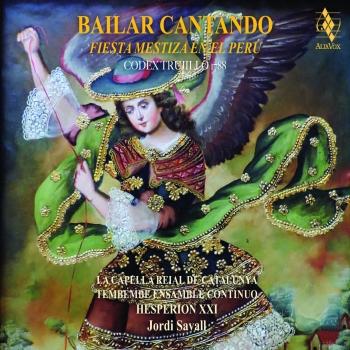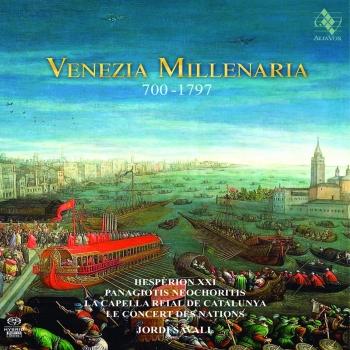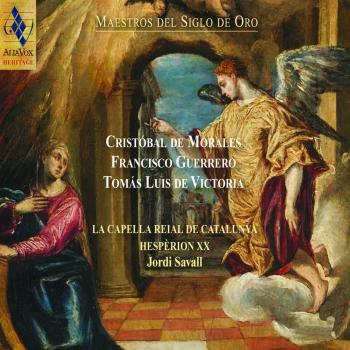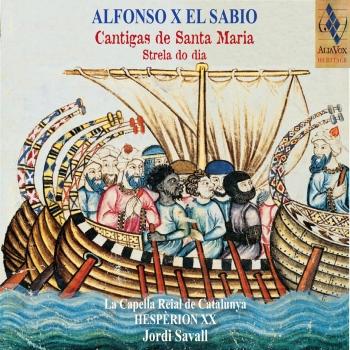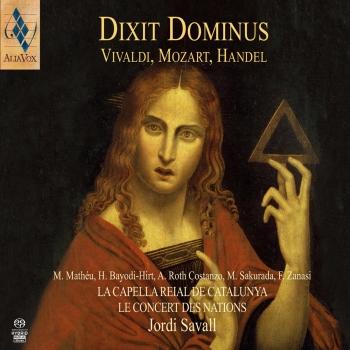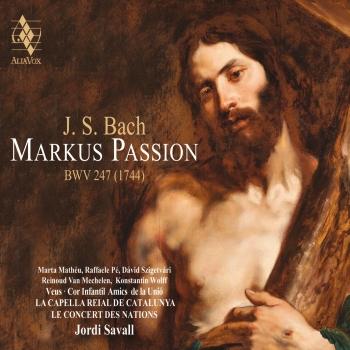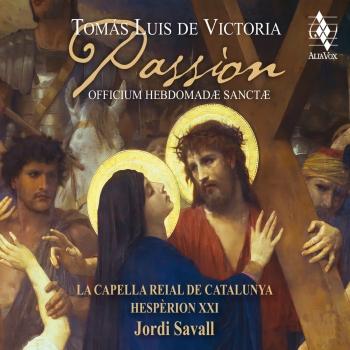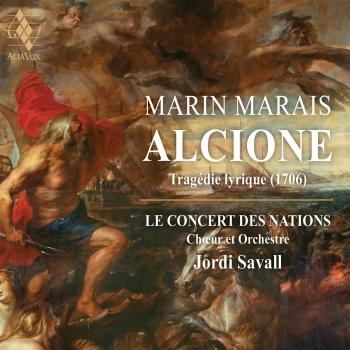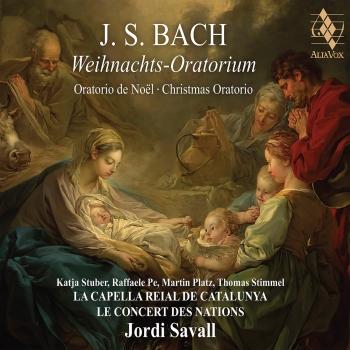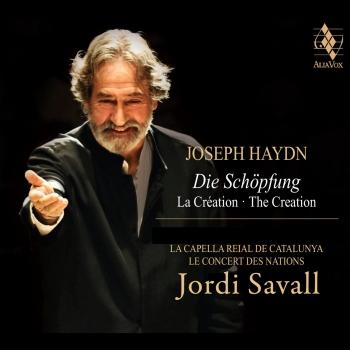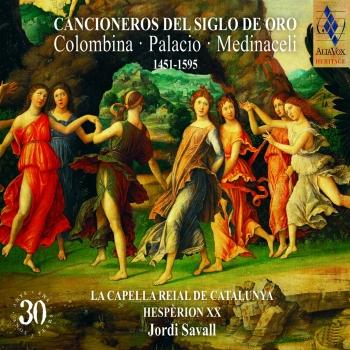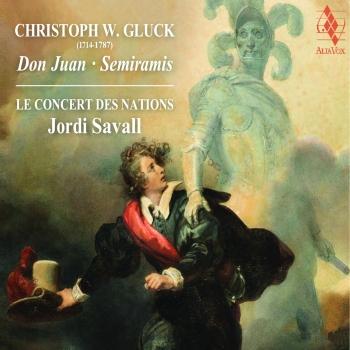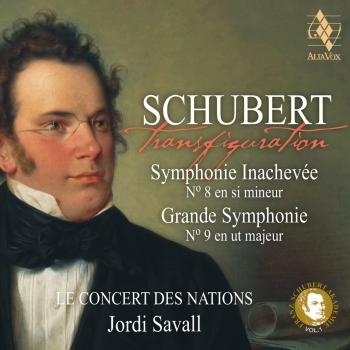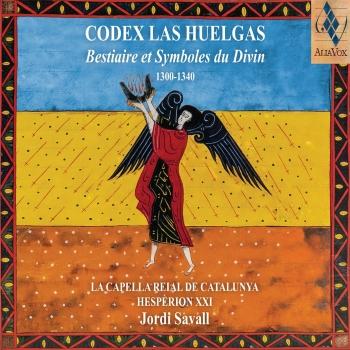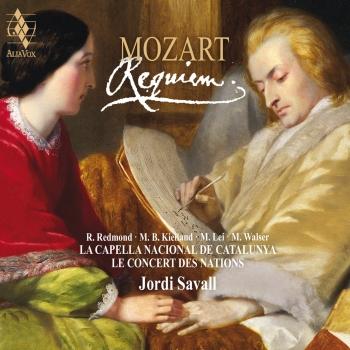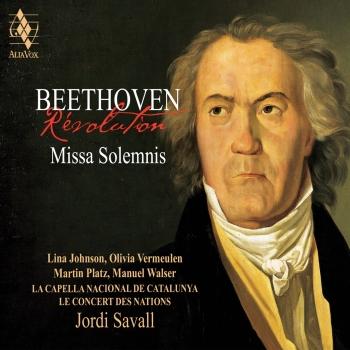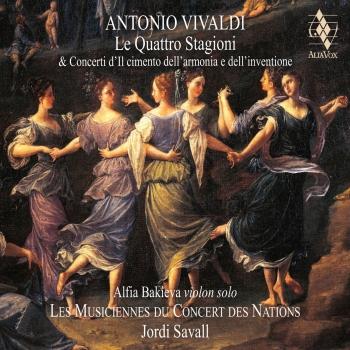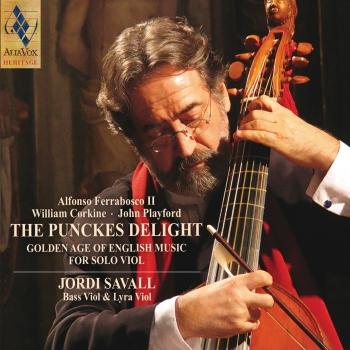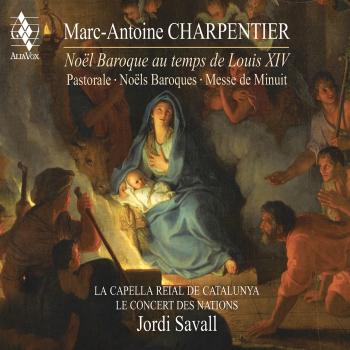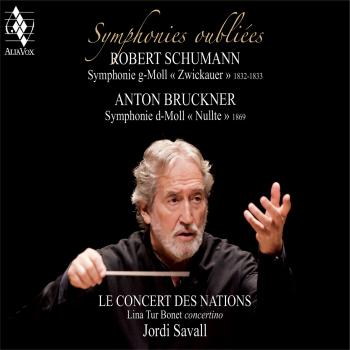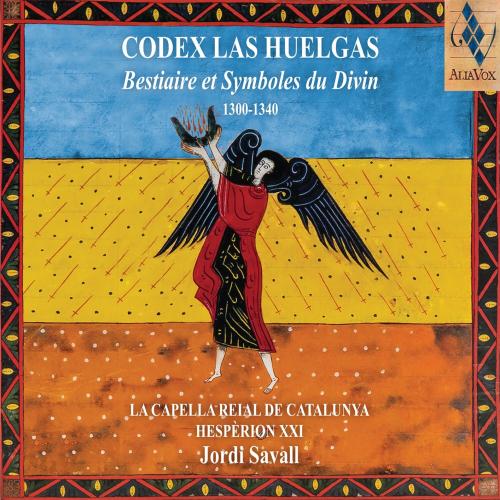
Codex Las Huelgas Jordi Savall
Album Info
Album Veröffentlichung:
2022
HRA-Veröffentlichung:
20.01.2023
Label: Alia Vox
Genre: Classical
Subgenre: Vocal
Interpret: Jordi Savall
Komponist: Bestiaire et Symboles du Divin (1300-1340)
Das Album enthält Albumcover
- Codex Las Huelgas:
- 1 Anonymous: Codex Las Huelgas: I. Iocundare plebs fidelis cuius Pater est in celis (Prose CLH 67) 06:48
- 2 Anonymous: Codex Las Huelgas: II. Audi pontus audi tellus (Conductus CLH 161) 05:13
- 3 Anonymous: Codex Las Huelgas: III. Eterni numinis (Prose VI de Santa María la Real CLH 55) 06:36
- 4 Anonymous: Codex Las Huelgas: IV. Kyrie fons bonitatis (Organum CLH 3) 04:26
- 5 Anonymous: Codex Las Huelgas: V. Gaude Virgo plena Deo (Prose IX de Santa María CLH 76) 05:06
- 6 Anonymous: Codex Las Huelgas: VI. Alpha bovi et leoni (Motet XXVIII CLH 83) 03:49
- 7 Anonymous: Codex Las Huelgas: VII. Virgines egregie (Prose XXIII de la Vierge CLH 72) 04:39
- 8 Anonymous: Codex Las Huelgas: VIII. Cum sint difficilia Salomoni tria (Notre-Dame Conductus mss. Firenze P9) 03:25
- 9 Anonymous: Codex Las Huelgas: IX. Virgo sidus aureum (Prose VIII de Santa María CLH 57) 14:25
- 10 Anonymous: Codex Las Huelgas: X. O Maria Virgo Davitica O Maria maris stella (Motet XXI CLH 104) 05:38
- 11 Anonymous: Codex Las Huelgas: XI. Flavit auster (Prose XL de Santa María CLH 58) 04:10
Info zu Codex Las Huelgas
Im Klosterleben des Zisterzienserordens, so auch im Frauenkloster Santa María la Real de Las Huelgas (Burgos), Begräbnisstätte der königlichen Familie, Schauplatz von Krönungen und Epizentrum eines intensiven musikalischen Lebens, in dem Gesang eine bedeutende Rolle spielte, waren die Nonnen zu einem Leben in Einfachheit, Stille, Gebet und Besinnlichkeit angehalten. Flavit auster, Teil des Codex Las Huelgas, ist ein marianischer Text, inspiriert am Lied der Lieder, in dem die stärksten Symbole der Weiblichkeit auftauchen, wie der Bienenstock aus Milch und Honig und die Schutzgebärde, beschrieben als „Mutter der Gnade, Hafen der Hoffnung für die Schiffbrüchigen und geläuterte jungfräuliche Mutter“. Diese Symbole finden sich bereits im 9. Jahrhundert in der islamischen und hebräischen Spiritualität. Sie wollen aufzeigen, was die Reise in das eigene Innere ausmacht: einen Weg der Herausforderung, des Wissens, des Zusammentreffens und der Vereinigung der Seele mit Gott. Mit den Worten der hl. Teresa von Ávila: „Seht diese schöne und strahlende Burg und diese wunderschöne orientalische Perle, diesen Baum des Lebens, der inmitten der lebendigen Wasser des Lebens gepflanzt ist“.
Neben dieser faszinierenden lichtreichen Symbolik der Königin des Himmels finden sich in diesem Kodex aus dem Kloster Las Huelgas zwischen Sternen, Goldstern, Sonne und Mond sowie Milch und Honig, Blumen, Juwelen des Frühlings, Rosen, Veilchen, Safran und Lorbeer viele Symbole der Tiere Christi, wie sie in den ersten Zeiten des Christentums präsent waren. Erinnern wir uns daran, dass auf den Fresken der ersten christlichen Katakomben und auf den byzantinischen Mosaiken Schafe, Tauben und Fische zu sehen sind. Die Realität dieser Welt wird in mystischer Form und zugleich verschleiert widergespiegelt. Das Christentum wurzelt auf der Lehre Platons: Dieser neue Glaube wurde in diesem philosophischen Kontext geboren, der wiederum von ägyptischer, und, darüber hinaus, hinduistischer Weisheit durchdrungen war.
Das erste christliche Bestiarium, der Physiologus, wurde vermutlich in Syrien im 3. Jahrhundert verfasst. Dieser grundlegende Text nährte die Vorstellungskraft späterer Künstler und Theologen. Die spanische Ars antiqua hat viele Werke bewahrt, in denen Tiere als Allegorien des Glaubens dienen, die mit den zwei- und vierbeinigen Gefährten des mittelalterlichen Menschen verschmelzen. Neben den grundlegenden marianischen Symbolen wie Adler, Schaf, Fisch und natürlich Taube gibt es weitere, eher unerwartete Kreaturen wie die „abscheulichen“ Fliegen, die traditionell den Herrn der Finsternis begleiten, aber auch den Pelikan, Symbol des Opfertods Jesu Christi, oder den Drachen als Wächter der Grenzen der bekannten Welt. Dieses Flammen speiende Ungeheuer stand zunächst für Wachsamkeit und Inbrunst, bevor es vom hl. Georg und Siegfried getötet wurde.
Es ist auch in diesem Kodex, wo (wie in den Fauxbourdons von Notre Dame de Paris und in den Pilgergesängen des Llibre Vermell von Montserrat) die ersten mehrstimmigen Gesänge, Fauxbourdons und erste musikalische Experimente mit unabhängigen, gleichzeitig gesungenen Melodien gemeinsam vorzufinden sind. Es handelte sich um den Beginn einer wahren Revolution, der Ars nova, aus der eine neue musikalische Sprache entstand, die von großen Komponisten wie Philippe de Vitry und Guillaume de Machaut meisterhaft entwickelt wurde. Zur selben Zeit, zu der sich die landeseigenen Sprachen durchsetzten, wurde die Musik mit dieser Ars nova zur wahren gemeinsamen Sprache Europas.
La Capella Reial de Catalunya
Hesperion XXI
Jordi Savall, Rebec, Fiedel, Leitung
Jordi Savall
Born on August 1, 1941, in Igualada, near Barcelona, Spain; married Montserrat Figueras (a musician), 1968. Education: Barcelona Conservatory, diploma; Schola Cantorum Basiliensis, diploma, 1970. Addresses: Record company---Naive Classique, 148 rue du Faubourg Possinière, 75010 Paris, France.
The works performed by Catalan gambist and conductor Jordi Savall span several centuries---from the music of Alfonso el Sabio, king of Castile and Léon, to the works of J. S. Bach---bringing to life the splendor and passion of bygone eras. A performance by Savall is more than a musical experience: the extraordinary power and beauty of his playing magically removes the listener from the flux of time, creating a space in which such obstacles to enjoyment as historical distance, stylistic peculiarities, and idiomatic enigmas simply disappear. For example, historical periods, including the Baroque, have often been described as "distant." Indeed, the physical and mental universe of seventeenth-century France may seem distant to a person living in the twenty-first century. But that distance vanishes when Savall plays the music of the great French master of the bass viol, Marin Marais.
First of all, Savall's main instrument is the viola da gamba, or bass viol (he also plays the smaller viols), not as a quaint relic that needs some special justification or antiquarian explanation. True, in the late 1700s, the viola da gamba---which is not a different kind of cello, but a member of the viol family, a distinct group of instruments of varying sizes---was supplanted by the cello, as the latter instrument, with its potential for virtuosity, satisfied the requirements of changing musical styles. However, to Savall, his instrument is irreplaceable. In fact, according to Savall, the viola da gamba has a particular sonic richness that the more "modern" cello lacks. As Savall explained to Chris Pasles of the Los Angeles Times, the "viola da gamba is totally different from a cello. It's closer to the lute---a lute with a bow, in fact. With six strings, frets like a guitar, a softer sound, it's more rich in different colors." Instead of merely reproducing a particular musical composition, Savall captures and expresses the timeless humanity of the music, illuminating the particular composition as a universally comprehensible document of the human experience. A case in point is Savall's mesmerizing performance of Marais's musical description, found in Book V of his Pièces de viole, of his gallstone operation. Written under the influence of François Couperin's character pieces, this extraordinary composition, especially in Savall's version, remains one of the most suggestively dramatic works of Baroque music.
Born in 1941, near the Catalan city of Barcelona, Savall began his musical education at the age of six. After graduation from the Barcelona Conservatory, where he studied the cello, Savall went to Basel, Switzerland, where he studied the viola da gamba with August Wenzinger at the Schola Cantorum Basiliensis, receiving a diploma in 1970. His other teachers included Wieland Kuijken, in Brussels. In 1973 Savall took over Wenzinger's post at the Schola Cantorum. By the early 1970s, Savall was already considered one the greatest viola da gamba players. In addition, he worked hard to enrich his instrument's repertoire, rescuing many works from oblivion and performing and recording numerous forgotten compositions. Savall thus exemplified, as he still does, the learned performer, who constantly studies the vast field of old music, bringing many neglected compositions to light. Among these lesser-known compositions are works by Marais, whose rich and fascinating oeuvre includes more than 500 pieces for viola da gamba and keyboard accompaniment, assembled in five books of his Pièces de viole.
In 1974 Savall and his wife, soprano Montserrat Figueras, founded Hespèrion XX---later, in the twenty-first century, known as Hespèrion XXI---an international ensemble that has gained great acclaim for its extraordinary performances of music from the Middle Ages to the Baroque. In 1987, returning to his native city after his extensive sojourn in foreign lands, Savall formed the Capella Reial de Catalunya, a vocal group that, under his direction, has performed and recorded music by Tomáa Luis de Victoria, Francisco Guerrero, and Claudio Monteverdi.
In 1989, further expanding his repertoire and musical activities, Savall founded the Concert des Nations, an ensemble consisting of younger musicians from Spain and Latin America. Under Savall's direction, this orchestra, which plays on period instruments, has recorded a variety of works from the Baroque and Classical periods.
Savall's career received a tremendous boost when film director Alain Corneau asked him to play on the soundtrack for Tous les matins du monde, his 1992 film about Marais and his teacher, Sainte-Colombe. Based on Pascal Quignard's admirable 1991 novel--available in English as All the World's Mornings--which imagines the life of the mysterious Sieur de Sainte-Colombe, the film is a spell-binding portrait of seventeenth-century France with the music, performed by Savall, providing a foundation for the narrative. Savall himself indirectly inspired Quignard's novel: it was a 1976 recording by Savall that introduced the writer to Sainte-Colombe's music. The music that Savall performs on the soundtrack is mostly by Marais and Sainte-Colombe, though it also includes a segment of François Couperin's deeply spiritual Leçons des ténèbres. Savall is inspired in his performance of the heartrending Tombeau les regrets, which, in Quignard's imagination, Sainte-Colombe played to conjure up the spirit of his deceased wife. In Savall's hands, this music, which appears as a leitmotif throughout the film, graces the rich tapestry of the film as a mysterious aura.
In 1988 the French Ministry of Culture awarded Savall the title of Officier de l'Ordre des Arts et Lettres. His recordings, numbering more than one hundred, have received many awards, including the Double Disc of Gold and the Diapason d'Or. In 1997 Savall's recording company, Astrée, founded a separate label, Fontalis, for his recordings. The following year, Savall started his own label, Alia Vox, which later reissued many of his earlier recordings at an affordable price. Savall's remarkable career is more than a personal triumph: thanks to his superb musicianship, the viola de gamba has emerged from the shadows of the past, becoming the instrument of choice for many younger performers. For such performers, the rich repertoire of the Renaissance and Baroque offers not only infinite artistic challenges and possibilities but the opportunity to abolish the somewhat artificial barrier separating "early" music from the rest of the musical tradition. (Zoran Minderovic)
Dieses Album enthält kein Booklet










